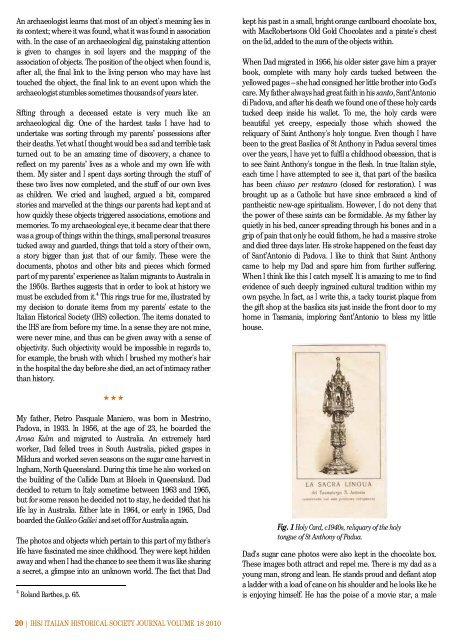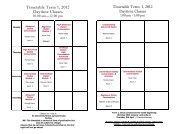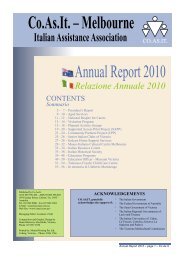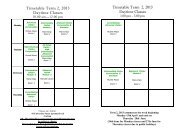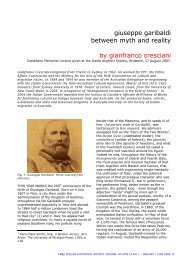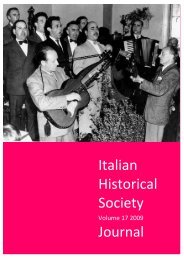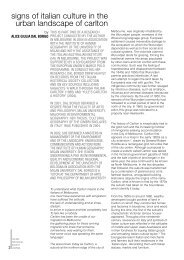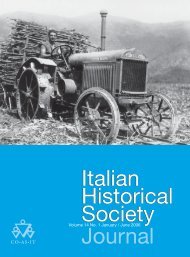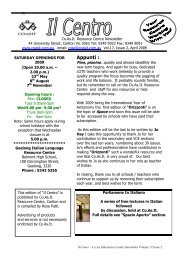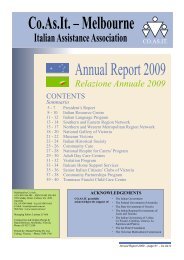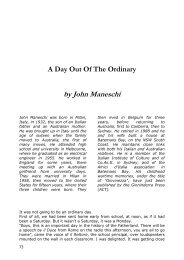January-December 2010, vol. 1
January-December 2010, vol. 1
January-December 2010, vol. 1
- No tags were found...
You also want an ePaper? Increase the reach of your titles
YUMPU automatically turns print PDFs into web optimized ePapers that Google loves.
An archaeologist learns that most of an object's meaning lies inits context; where it was found, what it was found in associationwith. In the case of an archaeological dig, painstaking attentionis given to changes in soil layers and the mapping of theassociation of objects. The position of the object when found is,after all, the final link to the living person who may have lasttouched the object, the final link to an event upon which thearchaeologist stumbles sometimes thousands of years later.Sifting through a deceased estate is very much like anarchaeological dig. One of the hardest tasks I have had toundertake was sorting through my parents’ possessions aftertheir deaths. Yet what I thought would be a sad and terrible taskturned out to be an amazing time of discovery, a chance toreflect on my parents’ lives as a whole and my own life withthem. My sister and I spent days sorting through the stuff ofthese two lives now completed, and the stuff of our own livesas children. We cried and laughed, argued a bit, comparedstories and marvelled at the things our parents had kept and athow quickly these objects triggered associations, emotions andmemories. To my archaeological eye, it became clear that therewas a group of things within the things, small personal treasurestucked away and guarded, things that told a story of their own,a story bigger than just that of our family. These were thedocuments, photos and other bits and pieces which formedpart of my parents’ experience as Italian migrants to Australia inthe 1950s. Barthes suggests that in order to look at history wemust be excluded from it. 4 This rings true for me, illustrated bymy decision to donate items from my parents' estate to theItalian Historical Society (IHS) collection. The items donated tothe IHS are from before my time. In a sense they are not mine,were never mine, and thus can be given away with a sense ofobjectivity. Such objectivity would be impossible in regards to,for example, the brush with which I brushed my mother's hairin the hospital the day before she died, an act of intimacy ratherthan history.kept his past in a small, bright orange cardboard chocolate box,with MacRobertsons Old Gold Chocolates and a pirate's cheston the lid, added to the aura of the objects within.When Dad migrated in 1956, his older sister gave him a prayerbook, complete with many holy cards tucked between theyellowed pages – she had consigned her little brother into God'scare. My father always had great faith in his santo, Sant’Antoniodi Padova, and after his death we found one of these holy cardstucked deep inside his wallet. To me, the holy cards werebeautiful yet creepy, especially those which showed thereliquary of Saint Anthony's holy tongue. Even though I havebeen to the great Basilica of St Anthony in Padua several timesover the years, I have yet to fulfil a childhood obsession, that isto see Saint Anthony's tongue in the flesh. In true Italian style,each time I have attempted to see it, that part of the basilicahas been chiuso per restauro (closed for restoration). I wasbrought up as a Catholic but have since embraced a kind ofpantheistic new-age spiritualism. However, I do not deny thatthe power of these saints can be formidable. As my father layquietly in his bed, cancer spreading through his bones and in agrip of pain that only he could fathom, he had a massive strokeand died three days later. His stroke happened on the feast dayof Sant’Antonio di Padova. I like to think that Saint Anthonycame to help my Dad and spare him from further suffering.When I think like this I catch myself. It is amazing to me to findevidence of such deeply ingrained cultural tradition within myown psyche. In fact, as I write this, a tacky tourist plaque fromthe gift shop at the basilica sits just inside the front door to myhome in Tasmania, imploring Sant’Antonio to bless my littlehouse.My father, Pietro Pasquale Maniero, was born in Mestrino,Padova, in 1933. In 1956, at the age of 23, he boarded theArosa Kulm and migrated to Australia. An extremely hardworker, Dad felled trees in South Australia, picked grapes inMildura and worked seven seasons on the sugar cane harvest inIngham, North Queensland. During this time he also worked onthe building of the Callide Dam at Biloela in Queensland. Daddecided to return to Italy sometime between 1963 and 1965,but for some reason he decided not to stay, he decided that hislife lay in Australia. Either late in 1964, or early in 1965, Dadboarded the Galileo Galilei and set off for Australia again.The photos and objects which pertain to this part of my father'slife have fascinated me since childhood. They were kept hiddenaway and when I had the chance to see them it was like sharinga secret, a glimpse into an unknown world. The fact that Dad4 Roland Barthes, p. 65.Fig. 1 Holy Card, c1940s, reliquary of the holytongue of St Anthony of Padua.Dad's sugar cane photos were also kept in the chocolate box.These images both attract and repel me. There is my dad as ayoung man, strong and lean. He stands proud and defiant atopa ladder with a load of cane on his shoulder and he looks like heis enjoying himself. He has the poise of a movie star, a male20 | IHSJ ITALIAN HISTORICAL SOCIETY JOURNAL VOLUME 18 <strong>2010</strong>


